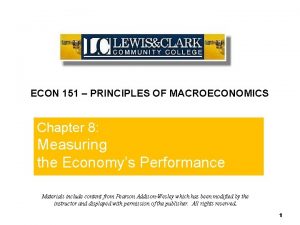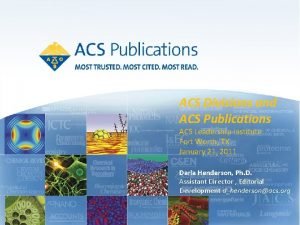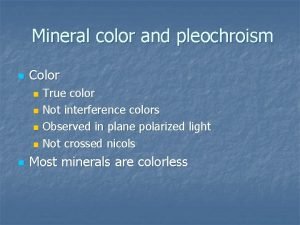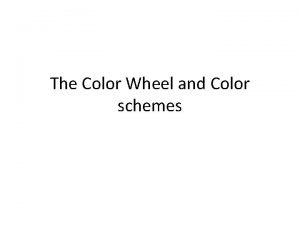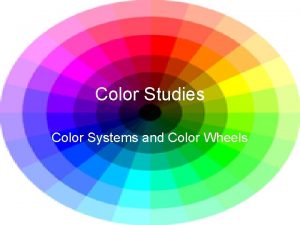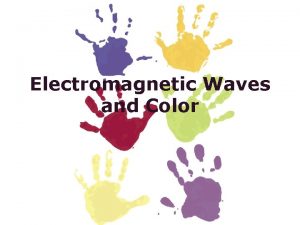ACS Outreach Chemistry 151 Chemistry and Color from
























- Slides: 24

ACS Outreach Chemistry 151 Chemistry and Color (from an elementary school perspective)

Electromagnetic radiation • Light is a form of energy that travels through space like a wave and is characterized by its wavelength.

Electromagnetic radiation • Only certain wavelengths of light (visible light) can be detected by the human eye. • “White” light is actually composed of all colors in equal amounts.

Color Perception • Objects appear colored when they reflect light of that color. • Red cone cells in the eye respond, signalling to the brain that the apple is “red”.

Pigments • Pigments are molecules that absorb certain colors of light and reflect the others. • A pigment absorbs light complementary observed color. generally that is to the • Absorbance data can be correlated to the identity of pigment.

Pigments • The absorbance of light can be measured with a spectophotometer.

Pigments • A purple pigment absorbs yellow-green light.

Pigments Food Coloring Data: Color Absorbance Max Yellow 425 nm (absorbs violet) Red 522 nm (absorbs cyan) Blue 610 nm (absorbs orange)

Pigments • Adding magenta, cyan, and yellow pigments in equal proportions leads to black. • Adding magenta, cyan, and yellow pigments in unequal proportions leads to all possible colors of pigments. Magenta, cyan, and yellow are the primary colors of pigments.

Primary Colors of Pigments • Equally adding adjacent pigments leads to the development of color wheels. primary colors secondary colors tertiary colors

Complementary colors • Colors opposite each other on color wheels are complementary colors. green cyan blue yellow red magenta • Pigments of complementary colors add in equal amounts to give black.

Complementary colors Yellow and blue Red and cyan Magenta and green

2012: Color Wheels Primary and secondary colors are introduced to show that some colors are made when mixing other colors together. Students make their own color wheels using homemade paint. Teko Mmolowa ’ 12

Colors in art • Paints are a homogeneous mixture of a pigment, which provides color, and a binder, which cements the pigment to the solid support after drying.


Pigments in nature • Early artists had primarily earth tones in their palettes, many mineral-based. charcoal brown ochre

Mineral-Based (Inorganic) Pigments hematite (Fe 2 O 3 · n. H 2 O) is a source of red, yellow, and brown ochre cinnabar (Hg. S) is a source of the red pigment vermilion azurite (2 Cu. CO 3 · Cu(OH)2)

Plant & Animal-Based (Organic) Pigments Indigo Tyrian purple Madder lake (alizarin)

Common Sources of Pigments Marigolds Grape Juice Beets Cochineal Beetles Walnut hulls Kool-Aid

CH 112: Color Activity Learning Goals: • Investigate the interaction of dyes with different fabrics. • Identify ionic and polar groups in dyes and fabrics. • Identify the different types of bonding interactions between dyes and fabrics.

The chemistry of fraud detection History of blue pigment use Pigment/Metal Azurite/Cu Ultramarine/Al Prussian Blue/Fe Synthetic Ultramarine/Al Cerulean Blue/Co, Sn Manganese Blue/Mn Dates in use until 1800 until 1828 post-1704 post-1828 post-1850 post-1935

2008: Art Fraud Activity Alfredo Fettuccini 1600 - 1650 Last Friday, a priceless masterpiece was stolen from the little-known Waterville Museum of Old Weird Art. The painting was the masterpiece of the great Italian finger painter, Alfredo Fettuccini. However, yesterday the caretaker told police he forgot he had taken the painting home to clean it, and found it in his bedroom the next morning. An original painting by Fettuccini and the painting produced by the caretaker have been confiscated, packaged, and sent to the Colby Chemistry Lab for analysis.

The case of the missing masterpiece You suspect that the caretaker, Ebenezer Wheezingeezer, stole the real painting and replaced it with a fake. You will investigate the pigments used in the paintings and then look for clues on the paintings themselves. The Waterville Museum of Old Weird Art has granted you Ebenezer special permission to handle these rare Wheezingeezer 1950 - ? ? paintings. The police are standing by, awaiting your judgment.

The case of the missing masterpiece • The following pigments were characterized: üPigment from the “Masterpiece” Ebenezer found üPigment from a modern painting üPigment found on the floor of the museum üPigment from a preserved brush of Fettuccini üPigment stain found on Ebenezer’s overalls • Techniques included absorbance spectroscopy, chemical tests for iron, p. H, and fluoresence.
 Chemistry 151 final exam
Chemistry 151 final exam Acs green chemistry
Acs green chemistry Cires education and outreach
Cires education and outreach Theodora okiro
Theodora okiro Objektif program
Objektif program Drug outreach team belfast
Drug outreach team belfast Sam nelson content
Sam nelson content Nesac outreach facility
Nesac outreach facility Deams outreach portal
Deams outreach portal Pch outreach program
Pch outreach program Mobile outreach safety team reno
Mobile outreach safety team reno Hpd mental health division
Hpd mental health division Georgia tech osha outreach portal
Georgia tech osha outreach portal National collaborative outreach programme
National collaborative outreach programme National guard employment network
National guard employment network Proactive patient outreach
Proactive patient outreach Gulf coast center angleton texas
Gulf coast center angleton texas Research outreach predatory
Research outreach predatory Community health education outreach programs
Community health education outreach programs Ladder safety ppt
Ladder safety ppt What is 326 rounded to the nearest ten
What is 326 rounded to the nearest ten Main event management
Main event management Conforme a tua infinita graça numero
Conforme a tua infinita graça numero Econ 151
Econ 151 Csc 151∘
Csc 151∘























